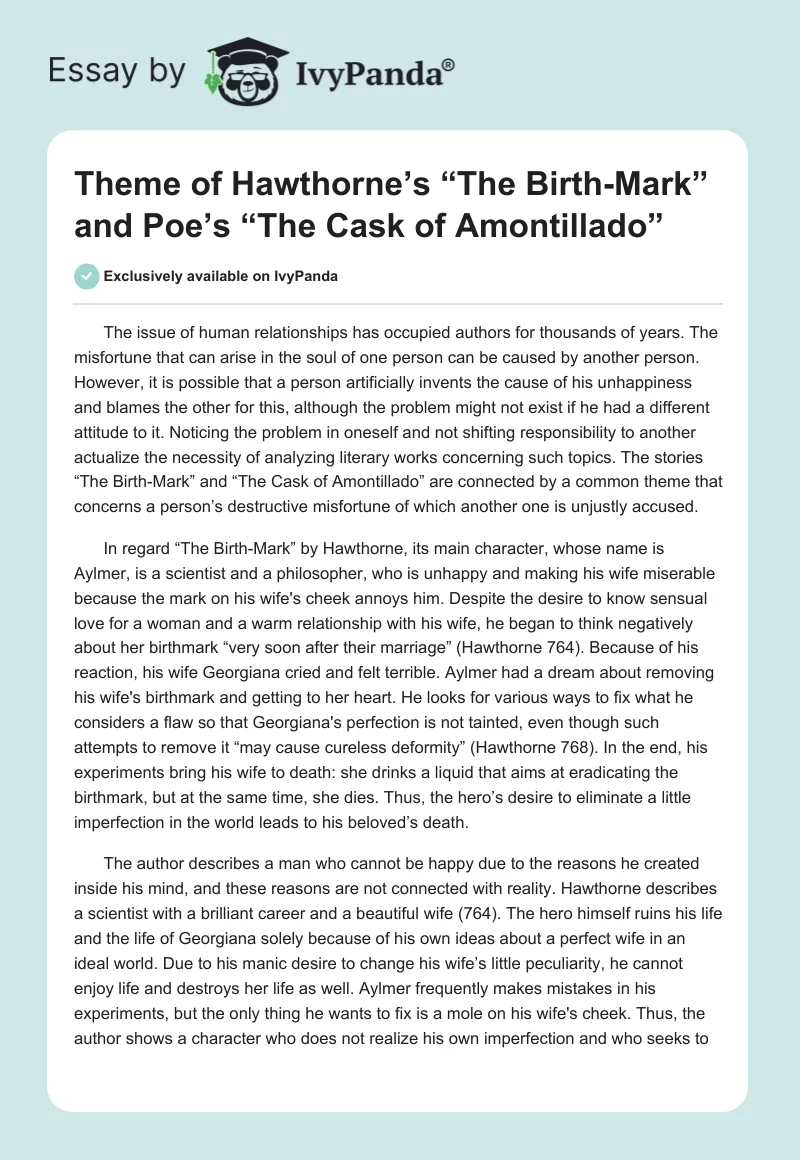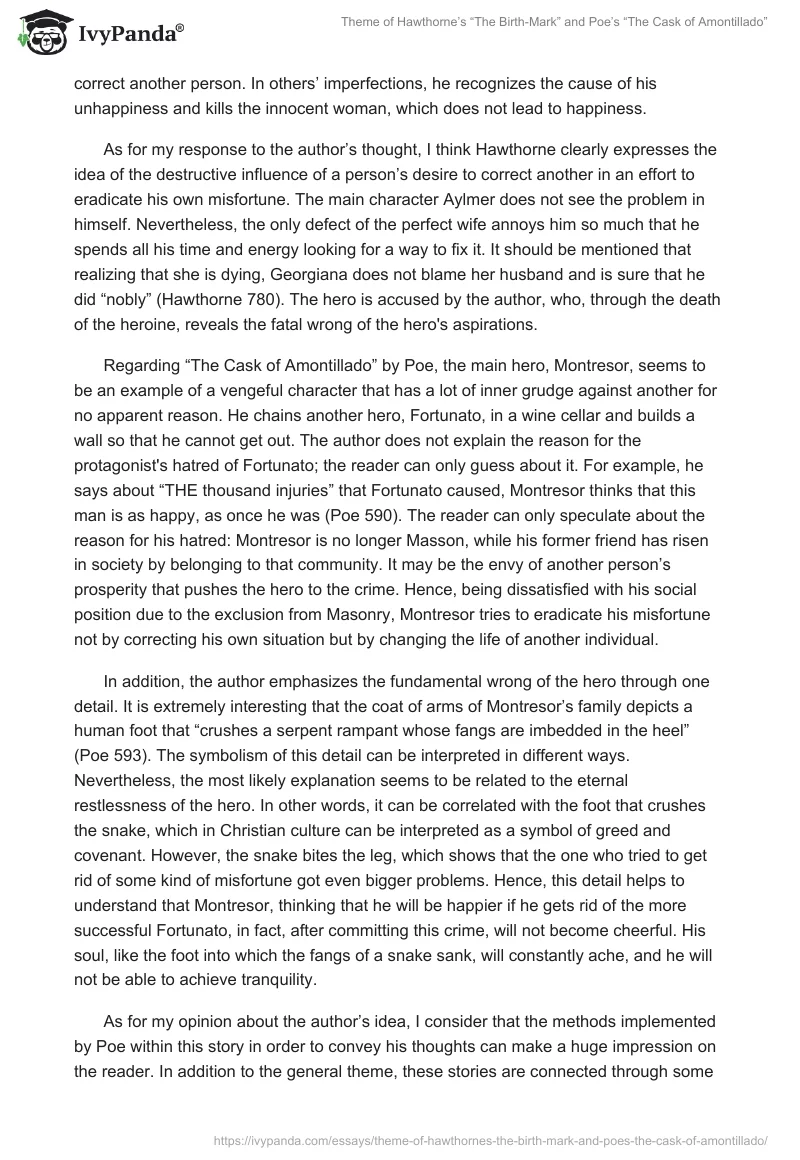The issue of human relationships has occupied authors for thousands of years. The misfortune that can arise in the soul of one person can be caused by another person. However, it is possible that a person artificially invents the cause of his unhappiness and blames the other for this, although the problem might not exist if he had a different attitude to it. Noticing the problem in oneself and not shifting responsibility to another actualize the necessity of analyzing literary works concerning such topics. The stories “The Birth-Mark” and “The Cask of Amontillado” are connected by a common theme that concerns a person’s destructive misfortune of which another one is unjustly accused.
In regard “The Birth-Mark” by Hawthorne, its main character, whose name is Aylmer, is a scientist and a philosopher, who is unhappy and making his wife miserable because the mark on his wife’s cheek annoys him. Despite the desire to know sensual love for a woman and a warm relationship with his wife, he began to think negatively about her birthmark “very soon after their marriage” (Hawthorne 764). Because of his reaction, his wife Georgiana cried and felt terrible. Aylmer had a dream about removing his wife’s birthmark and getting to her heart. He looks for various ways to fix what he considers a flaw so that Georgiana’s perfection is not tainted, even though such attempts to remove it “may cause cureless deformity” (Hawthorne 768). In the end, his experiments bring his wife to death: she drinks a liquid that aims at eradicating the birthmark, but at the same time, she dies. Thus, the hero’s desire to eliminate a little imperfection in the world leads to his beloved’s death.
The author describes a man who cannot be happy due to the reasons he created inside his mind, and these reasons are not connected with reality. Hawthorne describes a scientist with a brilliant career and a beautiful wife (764). The hero himself ruins his life and the life of Georgiana solely because of his own ideas about a perfect wife in an ideal world. Due to his manic desire to change his wife’s little peculiarity, he cannot enjoy life and destroys her life as well. Aylmer frequently makes mistakes in his experiments, but the only thing he wants to fix is a mole on his wife’s cheek. Thus, the author shows a character who does not realize his own imperfection and who seeks to correct another person. In others’ imperfections, he recognizes the cause of his unhappiness and kills the innocent woman, which does not lead to happiness.
As for my response to the author’s thought, I think Hawthorne clearly expresses the idea of the destructive influence of a person’s desire to correct another in an effort to eradicate his own misfortune. The main character Aylmer does not see the problem in himself. Nevertheless, the only defect of the perfect wife annoys him so much that he spends all his time and energy looking for a way to fix it. It should be mentioned that realizing that she is dying, Georgiana does not blame her husband and is sure that he did “nobly” (Hawthorne 780). The hero is accused by the author, who, through the death of the heroine, reveals the fatal wrong of the hero’s aspirations.
Regarding “The Cask of Amontillado” by Poe, the main hero, Montresor, seems to be an example of a vengeful character that has a lot of inner grudge against another for no apparent reason. He chains another hero, Fortunato, in a wine cellar and builds a wall so that he cannot get out. The author does not explain the reason for the protagonist’s hatred of Fortunato; the reader can only guess about it. For example, he says about “THE thousand injuries” that Fortunato caused, Montresor thinks that this man is as happy, as once he was (Poe 590). The reader can only speculate about the reason for his hatred: Montresor is no longer Masson, while his former friend has risen in society by belonging to that community. It may be the envy of another person’s prosperity that pushes the hero to the crime. Hence, being dissatisfied with his social position due to the exclusion from Masonry, Montresor tries to eradicate his misfortune not by correcting his own situation but by changing the life of another individual.
In addition, the author emphasizes the fundamental wrong of the hero through one detail. It is extremely interesting that the coat of arms of Montresor’s family depicts a human foot that “crushes a serpent rampant whose fangs are imbedded in the heel” (Poe 593). The symbolism of this detail can be interpreted in different ways. Nevertheless, the most likely explanation seems to be related to the eternal restlessness of the hero. In other words, it can be correlated with the foot that crushes the snake, which in Christian culture can be interpreted as a symbol of greed and covenant. However, the snake bites the leg, which shows that the one who tried to get rid of some kind of misfortune got even bigger problems. Hence, this detail helps to understand that Montresor, thinking that he will be happier if he gets rid of the more successful Fortunato, in fact, after committing this crime, will not become cheerful. His soul, like the foot into which the fangs of a snake sank, will constantly ache, and he will not be able to achieve tranquility.
As for my opinion about the author’s idea, I consider that the methods implemented by Poe within this story in order to convey his thoughts can make a huge impression on the reader. In addition to the general theme, these stories are connected through some details. For example, in both stories, the heroes offer the other characters a drink: Aylmer gives his wife his experimental liquid that will kill her, and Montresor proposes Fortunato wine to keep him drunk and vulnerable. Liquid as a symbol of the transience of life’s path can be a metaphor for the fact that the heroes’ problems will not disappear. The liquid motif shows that, despite their attempts, nothing will change since they chose the wrong path: they changed not themselves but others.
To conclude, the idea connecting the two analyzed stories is that one who is not ready to take responsibility for his misery and wants to change it at the expense of another person will remain unhappy. The stories share common motifs, such as death, misery, and the liquid. Both stories end with the death of an innocent character that, not being the true cause of someone else’s misfortune, became a victim of the mental anxiety of another character.
Works Cited
Hawthorne, Nathaniel. Tales and Sketches. The Library of America, 1982.
Poe, Edgar Allan. Complete Stories and Poems of Edgar Allan Poe. Doubleday, 1966.


